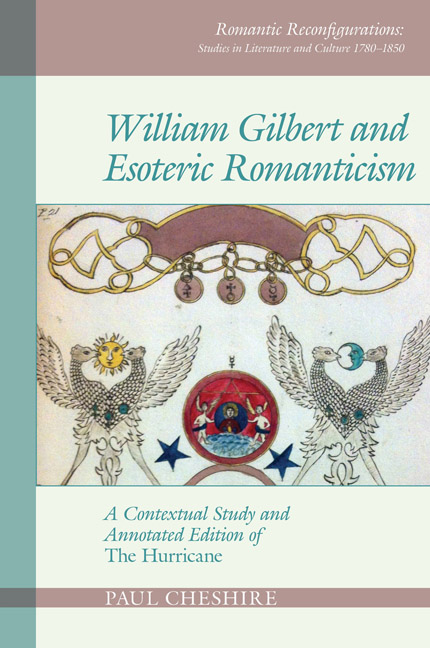 William Gilbert and Esoteric Romanticism
William Gilbert and Esoteric Romanticism from Part One - William Gilbert in Romantic Culture
Twas Nature taught my early youth Religion—Nature bade me see the God Confest in all that lives, and moves, and is.’
Joan of Arc (1796), III: lines 389–91After Coleridge's removal to Nether Stowey at the end of 1796, Robert Southey took on the task of promoting The Hurricane on Gilbert's behalf:
I wish Bob would insert a review of my writing in the British Critic. it is upon a strange poem with still stranger notes, written by a man of brilliant genius & polishd manners who is deranged. it is easy to imply this without doing it in such terms as would wound his feelings. the book is ‘the Hurricane a Theosophical & Western Eclogue by William Gilbert.’ Gilbert has been called to the bar. he was clerk to the House of Commons at Antigua, & came to England as Counsel on a celebrated cause in the annals of Military Law. I know him & pity him —
where a sight shall Sorrow find
Sad as the ruins of the human mind!
(RSL, 26 January 1797)Southey and Gilbert had known each other since May 1795, a period interrupted by Southey's absence in Portugal and possibly complicated by Southey's estrangement from Coleridge. This letter is the first surviving trace of their friendship and, although the review that Southey proposed was never written (RSL, 19 January 1798), on 18 May 1797 Southey was sending indirect apologies to Gilbert for being behind on correspondence, on 30 September 1797 he was referring to Gilbert as ‘my astrological friend’, and, when Gilbert went missing on 26 July 1798, it was Southey – as we shall see – who sprang into action.
In the light of Southey's reputation as the dependable man who supported Coleridge's wife and children following their separation, it would be easy to read this promotion of The Hurricane as another instance of Southey as supportive friend, trying to help poor ‘deranged’ Gilbert. But the following extract from a letter he sent to Cottle shows the depth of his fascination:
I have lost myself in the bottomless profundity of Gilbert's papers. Fire, and water, and cubes, and sybils, and Mother Church, &c. &c. Poor fellow. I have been introduced to a man, not unlike him in his ideas,—Taylor the Pagan, a most devout Heathen! who seems to have some hopes of me.
To save this book to your Kindle, first ensure [email protected] is added to your Approved Personal Document E-mail List under your Personal Document Settings on the Manage Your Content and Devices page of your Amazon account. Then enter the ‘name’ part of your Kindle email address below. Find out more about saving to your Kindle.
Note you can select to save to either the @free.kindle.com or @kindle.com variations. ‘@free.kindle.com’ emails are free but can only be saved to your device when it is connected to wi-fi. ‘@kindle.com’ emails can be delivered even when you are not connected to wi-fi, but note that service fees apply.
Find out more about the Kindle Personal Document Service.
To save content items to your account, please confirm that you agree to abide by our usage policies. If this is the first time you use this feature, you will be asked to authorise Cambridge Core to connect with your account. Find out more about saving content to Dropbox.
To save content items to your account, please confirm that you agree to abide by our usage policies. If this is the first time you use this feature, you will be asked to authorise Cambridge Core to connect with your account. Find out more about saving content to Google Drive.